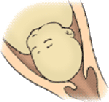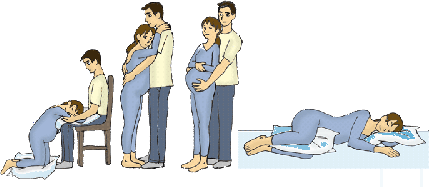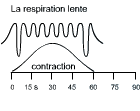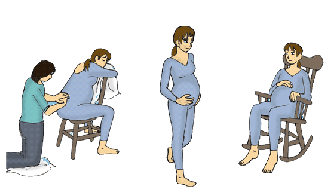First Stage
| 1. Early Labour | ||
|
What is happening |
How you may feel |
|
 |
The cervix is thinning and opening from 1 cm to about 4 cm. The contractions
A pinkish mucous (mucous plug) comes out of the vagina. Sometimes this happens sooner. Your waters may break. You may need to urinate more often or have diarrhea. |
Excited Relieved that labour is beginning Afraid Talkative Anxious for the birth of the baby
|
 |
||
| What you can do | How a labour partner can help |
|
Carry on with your usual activities. Stay upright as long as possible. Walk. If your waters have not broken, shower or relax in a warm tub. Rest. At night, sleep if you can. Go to the bathroom as often as you need to. Eat and drink as you feel the need; it is important to maintain your energy. Even if you don't feel hungry, try to eat a light meal and be sure to get enough to drink. Breathe normally until walking or talking during a contraction becomes uncomfortable. Then, begin deep breathing as you need it. Go to the hospital when your contractions are coming regularly and about 5 minutes apart for a first child or 10 minutes apart if this is not your first child. You may call the hospital for advice. Go to the hospital immediately if your waters break. |
Stay with her. Encourage her. Help her to walk, relax, rest, and pass the time. Remind her to go to the bathroom. She will feel better if her bladder is empty. Encourage her to eat and drink. Time her contractions. Help her during her contractions.
Make sure that her suitcases are packed and ready to take to the hospital. Call the doctor and take her to the hospital when it is time. |
| Previous | Next |
| Guide to Labour and Delivery | 2. Active Labour |




